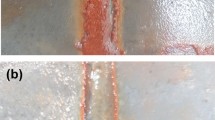Abstract
Coupons of stainless steel type AISI-304 were exposed to the industrial cooling system of a petrochemical plant fed by seawater from the Guanabara Bay, Rio de Janeiro, Brazil, in order to study thein situ formation of biofilms. Bacteria, microalgae and fungi were detected on the coupons as soon as 48 h after exposure. Their respective numbers were determined at times 48, 96 and 192 h and over the following 8 weeks. Aerobic, anaerobic and sulfate-reducing bacteria were quantified according to the technique of the most probable number, and fungi by the pour plate technique. The number of microorganisms present in the forming biofilm varied over the experimental period, reaching maximal levels of 14×1011 cells cm−2, 30×1013 cells cm−2, 38×1011 cells cm−2 and 63×105 cells cm−2, respectively, for aerobic bacteria, anaerobic bacteria, sulfate-reducing bacteria and fungi, and the dynamics of this variation depended on the group of microorganisms.Bacillus sp,Escherichia coli, Serratia sp andPseudomonas putrefaciens were identified among the aerobic bacteria isolated. Additionally, microalgae and bacteria of the genusGallionella were also detected. Nonetheless, no evidence of corrosion was found on the stainless steel type AISI-304 coupons over the experimental period.
Similar content being viewed by others
References
American Public Health Association (APHA). 1972. Tentative methods of analysis for hydrogen sulphide content of the atmosphere. In: Methods of Air Sampling and Analysis. pp 426–432, APHA, Washington.
American Public Health Association (APHA). 1992. In: Standard Methods for Examination of Water and Waste Water. pp. 9.78–9.83, APHA, Washington.
Brankevich G, P Guiamet and HA Videla. 1987. Corrosion del acero inoxidable AISI-304 en agua de mar poluida. Anais 14º Senacor, Associação Brasileira de Corrosão, Abraco, Brasil.
Characklis WG and KC Marshall. 1990. Biofilms: a basis for an interdisciplinary approach. In: Biofilms (Characklis WG and KC Marshall, eds), pp 3–15. John Wiley & Sons, New York.
Characklis WG, GA Mcfeters and KC Marshall. 1990. Physiological ecology in biofilms systems. In: Biofilms (Characklis WG and KC Marshall, eds), pp 341–394. John Wiley & Sons, New York.
Cook PE and CC Gaylarde. 1988. Biofilms formation in aqueous metal working fluids. Intern Biodet 24: 265–270.
Coutinho CMLM, FCM Magalhães and TCA Jorge. 1993. Scanning electron microscope study of biofilm formation at different flow rates over metal surfaces using sulphate-reducing bacteria. Biofouling 7: 19–27.
Gaylarde CC. 1991. Biofilms. In: Biocorrosão, Biofilmes e Biocidas. Vol I. Fund Tropical de Pesquisa e Tecnologia ‘André Tosello’.
Holt JG, NR Krieg, PHA Sneath, JT Stanley and ST Williams (eds). 1994. Bergey's Manual of Determinative Bacteriology. 9th edn. Williams & Wilkins, Baltimore.
Koch AL. 1981. Growth measurement. In: Manual of Methods for General Bacteriology (Gerhardt P, ed), pp 188–207, American Society for Microbiology, Washington.
National Association of Corrosion Engineers (NACE). 1976. The role of bacteria in the corrosion of oil field equipment. In: Technical Practices Committee No. 3. NACE, Houston, Texas.
Notermans S. 1994. The significance of biofouling to the food industry. Food Tech 7: 13–14.
Page S and CC Gaylarde. 1990. Biocide activity againstLegionella and Pseudomonas. Intern Biodet 26: 139–148.
Pope DH. 1991. Mechanisms of microbiologically influenced corrosion of carbon steels. In: Gas, Coal, Oil and Environmental Biotechnology III (Akin C and J Smith, eds), pp 499–509, Institute of Gas Technology, Chicago, USA.
Postgate JR. 1984. The Sulphate Reducing Bacteria. Cambridge University Press, Cambridge.
Rosemberg JA. 1976. O potencial das algas. Possibilidades deScenedesmus quadricauda isolada no Rio de Janeiro. Thesis. Universidade Federal do Rio de Janeiro, Brasil.
Videla HA. 1991. Interpretación biolectroquímica de la ruptura de la pasividade del acero sl carbono por bacterias sulfatoredutoras. Rev Iber Corros y Prot 22(1): 11–16.
Walsh D, J Seagoe and L. Williams. 1992. Microbiologically influenced corrosion of stainless steel weldments, attachment and film evolution. Corrosion, Paper No. 165, NACE, Texas.
Author information
Authors and Affiliations
Rights and permissions
About this article
Cite this article
de França, F.P., Lutterbach, M.T.S. Variation in sessile microflora during biofilm formation on AISI-304 stainless steel coupons. Journal of Industrial Microbiology 17, 6–10 (1996). https://doi.org/10.1007/BF01570140
Received:
Accepted:
Issue Date:
DOI: https://doi.org/10.1007/BF01570140




